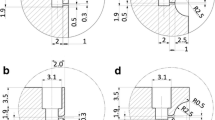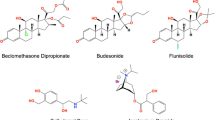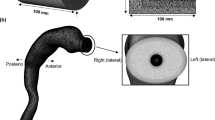ABSTRACT
Purpose
To investigate the influence of different actuator materials and nozzle designs on the electrostatic charge properties of a series of solution metered dose inhaler (pMDI) aerosols.
Methods
Actuators were manufactured with flat and cone nozzle designs using five different materials from the triboelectric series (Nylon, Polyethylene terephthalate, Polyethylene–High density, Polypropylene copolymer and Polytetrafluoroethylene). The electrostatic charge profiles of pMDI containing beclomethasone dipropionate (BDP) as model drug in HFA-134a propellant, with different concentrations of ethanol were studied. Electrostatic measurements were taken using a modified electrical low-pressure impactor (ELPI) and the deposited drug mass assayed chemically using HPLC.
Results
The charge profiles of HFA 134a alone have shown strong electronegativity with all actuator materials and nozzle designs, at an average of –1531.34 pC ± 377.34. The presence of co-solvent ethanol significantly reduced the negative charge magnitude. BDP reduced the suppressing effect of ethanol on the negative charging of the propellant. For all tested formulations, the flat nozzle design showed no significant differences in net charge between different actuator materials, whereas the charge profiles of cone designs followed the triboelectric series.
Conclusion
The electrostatic charging profiles from a solution pMDI containing BDP and ethanol can be significantly influenced by the actuator material, nozzle design and formulation components. Ethanol concentration appears to have the most significant impact. Furthermore, BDP interactions with ethanol and HFA have an influence on the electrostatic charge of aerosols. By choosing different combinations of actuator materials and orifice design, the fine particle fractions of formulations can be altered.









Similar content being viewed by others
REFERENCES
Chan TL, Yu CP. Charge effects on particle deposition in the human tracheobronchial tree. Ann Occup Hyg. 1982;26(1-4):65–75.
Melandri C, Prodi V, Tarroni G, Formignani M, Bompane GF, Dezaiacomo T, et al. Deposition of unipolarly charged-particles in human respiratory-tract. Health Phys. 1977;33(3):273.
Tarroni G, Melandri C, Prodi V, Dezaiacomo T, Formignani M, Bassi P. An indication on the biological variability of aerosol total deposition in humans. Am Ind Hyg Assoc J. 1980;41(11):826–31.
Fraser DA. Deposition of unipolar charged particles in lungs of animals. Arch Environ Health. 1966;13(2):152–61.
Ferin J, Mercer TT, Leach LJ. The effect of aerosol charge on the deposition and clearance of TiO2 particles in rats. Environ Res. 1983;31(1):148–51.
Vincent JH, Johnston WB, Jones AD, Johnston AM. Static electrification of airborne asbestos—a study of its causes, assessment and effects on deposition in the lungs of rats. Am Ind Hyg Assoc J. 1981;42(10):711–21.
Ingham DB. Precipitation of charged-particles in human airways. J Aerosol Sci. 1981;12(2):131–5.
Yu CP, Chandra K. Precipitation of submicron charged-particles in human lung airways. B Math Biol. 1977;39(4):471–8.
Diu CK, Yu CP. Deposition from charged aerosol flows through a pipe bend. J Aerosol Sci. 1980;11(4):397–402.
Thiagarajan V, Yu CP. Sedimentation from charged aerosol flows in parallel-plate and cylindrical channels. J Aerosol Sci. 1979;10(4):405–10.
Finlay WH. The mechanics of inhaled pharmaceutical aerosols: An introduction: Access Online via Elsevier; 2001
Kwok PCL, Chan HK. Electrostatics of pharmaceutical inhalation aerosols. J Pharm Pharmacol. 2009;61(12):1587–99.
Karner S, Urbanetz NA. The impact of electrostatic charge in pharmaceutical powders with specific focus on inhalation-powders. J Aerosol Sci. 2011;42(6):428–45.
Hao T, Tukianen J, Nivorozhkin A, Landrau N. Probing pharmaceutical powder blending uniformity with electrostatic charge measurements. Powder Technol. 2013
Pu Y, Mazumder M, Cooney C. Effects of electrostatic charging on pharmaceutical powder blending homogeneity. J Pharm Sci-Us. 2009;98(7):2412–21.
Šupuk E, Hassanpour A, Ahmadian H, Ghadiri M, Matsuyama T. Tribo-electrification and associated segregation of pharmaceutical bulk powders. KONA Powder and Particle Journal. 2011;29:208–23.
Mitchell JP, Coppolo DP, Nagel MW. Electrostatics and inhaled medications: influence on delivery via pressurized metered-dose inhalers and add-on devices. Respir Care. 2007;52(3):283–300.
Kwok PCL, Trietsch SJ, Kumon M, Chan HK. Electrostatic charge characteristics of jet nebulized aerosols. J Aerosol Med Pulm D. 2010;23(3):149–59.
Hoe S, Traini D, Chan HK, Young PM. The influence of flow rate on the aerosol deposition profile and electrostatic charge of single and combination metered dose inhalers. Pharmaceut Res. 2009;26(12):2639–46.
Kwok PCL, Glover W, Chan HK. Electrostatic charge characteristics of aerosols produced from metered dose inhalers. J Pharm Sci-Us. 2005;94(12):2789–99.
Adi H, Kwok PCL, Crapper J, Young PM, Traini D, Chan HK. Does electrostatic charge affect powder aerosolisation? J Pharm Sci-Us. 2010;99(5):2455–61.
Byron PR, Peart J, Staniforth JN. Aerosol electrostatics .1. Properties of fine powders before and after aerosolization by dry powder inhalers. Pharmaceut Res. 1997;14(6):698–705.
Hoe S, Young PM, Traini D. Dynamic electrostatic charge of lactose-salbutamol sulphate powder blends dispersed from a cyclohaler (R). Drug Dev Ind Pharm. 2011;37(11):1365–75.
Hoe S, Traini D, Chan HK, Young PM. The contribution of different formulation components on the aerosol charge in carrier-based dry powder inhaler systems. Pharmaceut Res. 2010;27(7):1325–36.
Kwok PCL, Chan HK. Effect of relative humidity on the electrostatic charge properties of dry powder inhaler aerosols. Pharmaceut Res. 2008;25(2):277–88.
Ali M, Mazumder MK, Martonen TB. Measurements of electrodynamic effects on the deposition of MDI and DPI aerosols in a replica cast of human oral-pharyngeal-laryngeal airways. J Aerosol Med Pulm D. 2009;22(1):35–44.
Newman SP. Principles of metered-dose inhaler design. Respir Care. 2005;50(9):1177–90.
Dunbar C. Atomisation mechanisms of the pressurized metered dose inhaler. Part Sci Technol. 1997;15(3–4):253–71.
Wiener M. How to formulate aerosols to obtain the desired spray pattern. J Soc Cosmet Chem. 1958;9:289–97.
Clark AR. MDIs: physics of aerosol formation. Journal of Aerosol Medicine. 1996;9(s1):S-19–26.
Newman S, Clarke S. Therapeutic aerosols 1–physical and practical considerations. Thorax. 1983;38(12):881–6.
Usmani OS, Biddiscombe MF, Barnes PJ. Regional lung deposition and bronchodilator response as a function of β2-agonist particle size. American journal of respiratory and critical care medicine. 2005;172(12):1497–504.
Dhand R, Malik S, Balakrishnan M, Verma S. High speed photographic analysis of aerosols produced by metered dose inhalers. J Pharm Pharmacol. 1988;40(6):429–30.
Newman SP. Aerosol deposition considerations in inhalation therapy. CHEST Journal. 1985;88(2):152S–60S.
Smyth HDC. The influence of formulation variables on the performance of alternative propellant-driven metered dose inhalers. Adv Drug Deliver Rev. 2003;55(7):807–28.
Wildhaber JH, Devadason SG, Eber E, Hayden M, Everard M, Summers Q, et al. Effect of electrostatic charge, flow, delay and multiple actuations on the in vitro delivery of salbutamol from different small volume spacers for infants. Thorax. 1996;51(10):985–8.
Kwok PCL, Collins R, Chan HK. Effect of spacers on the electrostatic charge properties of metered dose inhaler aerosols. J Aerosol Sci. 2006;37(12):1671–82.
Anhoj J, Bisgaard H, Lipworth BJ. Effect of electrostatic charge in plastic spacers on the lung delivery of HFA-salbutamol in children. Brit J Clin Pharmaco. 1999;47(3):333–6.
Kwok PCL, Noakes T, Chan HK. Effect of moisture on the electrostatic charge properties of metered dose inhaler aerosols. J Aerosol Sci. 2008;39(3):211–26.
Berry J, Heimbecher S, Hart JL, Sequeira J. Influence of the metering chamber volume and actuator design on the aerodynamic particle size of a metered dose inhaler. Drug Dev Ind Pharm. 2003;29(8):865–76.
Smyth H, Brace G, Barbour T, Gallion J, Grove J, Hickey AJ. Spray pattern analysis for metered dose inhalers: effect of actuator design. Pharmaceut Res. 2006;23(7):1591–6.
Smyth H, Hickey AJ, Brace G, Barbour T, Gallion J, Grove J. Spray pattern analysis for metered dose inhalers I: orifice size, particle size, and droplet motion correlations. Drug Dev Ind Pharm. 2006;32(9):1033–41.
Carter P, Rowley G, Roughley N, Suggett J. Electrostatic charge accumulation and decay in pharmaceutical polymer materials used in metered dose inhalers. J Pharm Pharmacol. 1998;50:55.
Bailey AG. Electrostatic phenomena during powder handling. Powder Technol. 1984;37:71–85.
Gallo CF, Lama WL. Classical electrostatic description of work function and ionization-energy of insulators. IEEE T Ind Appl. 1976;12(1):7–11.
Ndama AT, Guigon P, Saleh K. A reproducible test to characterise the triboelectric charging of powders during their pneumatic transport. J Electrostat. 2011;69(3):146–56.
Saleh K, Ndama AT, Guigon P. Relevant parameters involved in tribocharging of powders during dilute phase pneumatic transport. Chem Eng Res Des. 2011;89(12A):2582–97.
Bailey AG. Charging of solids and powders. J Electrostat. 1993;30:167–80.
Lacks DJ, Levandovsky A. Effect of particle size distribution on the polarity of triboelectric charging in granular insulator systems. J Electrostat. 2007;65(2):107–12.
Good RJ. Contact-angle, adhesion and wetting—a critical-review. Abstr Pap Am Chem S. 1992;203:2-COLL.
Girifalco LA, Good RJ, Balestic P, Magat M, Leftin HP, Hall WK, et al. A theory for estimation of surface and interfacial energies. 1. Derivation and application to interfacial tension (vol 61, pg 904, 1957). J Phys Chem-Us. 1960;64(12):1960.
Adamson A. Physical chemistry of surfaces. 4th ed. New York: Wiley-Interscience; 1982.
Lewis D. Determination of electrical parameters of some propellants. Personal email communication to the author May 2012.
Zhu B, Traini D, Chan HK, Young P. The Effect of Ethanol on the Formation and Physico-chemical Properties of Particles Generated from Solution-based Pressurized Metered Dose Inhalers. Drug Dev Ind Pharm. 2013.
Allen RC. Triboelectric generation: getting charged. Ee-Eval Eng. 2000;39(11):S4.
Akbulut M, Alig ARG, Israelachvili J. Triboelectrification between smooth metal surfaces coated with self-assembled monolayers (SAMs). J Phys Chem B. 2006;110(44):22271–8.
ACKNOWLEDGMENTS AND DISCLOSURES
This research was supported under Australian Research Council’s Linkage Projects funding scheme (project number LP100200156). A/Professor Young is the recipient of an Australian Research Council Future Fellowship (project number FT110100996). A/Professor Traini is the recipient of an Australian Research Council Future Fellowship (project number FT12010063).
Author information
Authors and Affiliations
Corresponding author
Rights and permissions
About this article
Cite this article
Chen, Y., Young, P.M., Fletcher, D.F. et al. The Influence of Actuator Materials and Nozzle Designs on Electrostatic Charge of Pressurised Metered Dose Inhaler (pMDI) Formulations. Pharm Res 31, 1325–1337 (2014). https://doi.org/10.1007/s11095-013-1253-7
Received:
Accepted:
Published:
Issue Date:
DOI: https://doi.org/10.1007/s11095-013-1253-7




